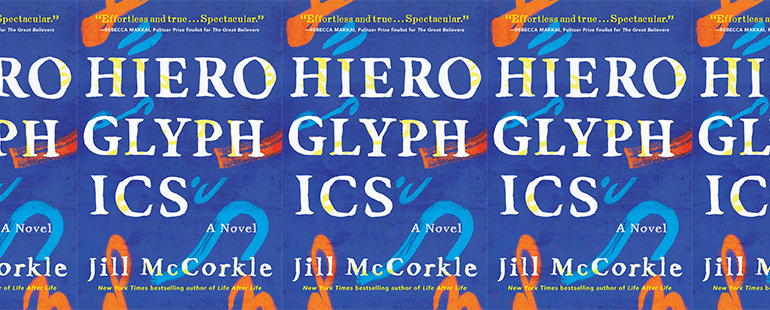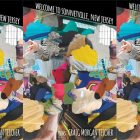Memory and Trauma in Hieroglyphics

My Religion teacher at a Catholic high school in Atlanta once told our class that she cried the day she gave birth to her son because she knew that one day he would die. Ten years later, my sister would die in my father’s arms. When I found out, one of my first thoughts was of Mrs. Lorenz describing her morbid realization to our class. Four years after that, I would hold my own child for the first time, trying to memorize the tiny features of his face while also imagining my sister’s last breath in my father’s arms and Mrs. Lorenz giving her child both life and death—the same fate that awaited the baby boy I held. In that moment, I was in three places at once, somehow feeling the magnitude of each, though two of the three were imagined pasts, my father’s and Mrs. Lorenz’s. These memories were stirred by Jill McCorkle’s new novel, Hieroglyphics, out today, which is obsessed with memory and trauma—how we are often living two lives at once, our bodies moving and doing in the present while our minds are simultaneously being drawn into the past, both real and imagined.
Hieroglyphics is a novel about how our futures are constructed by our past trauma and joy, how memory both haunts and informs the present. This subject matter is not new for McCorkle. Her previous books—Hieroglyphics is her seventh novel and eleventh fiction title—often move between different time periods and points of view, questioning how past events define future lives, and how those lives touch one another in surprising ways.
There are four points of view in this book: Lil, Frank, Shelley, and Harvey. Lil is a woman in her eighties, suffering from emphysema and dementia. She’s obsessed with remembering. Lil and Frank have been married for sixty-five years. They fell in love because of their shared heartbreak: each had lost a parent suddenly in childhood, Frank’s father dying in a train crash, Lil’s mother in a fire. Frank wants to end his life. They are both living in the past. Lil hangs onto her diminished days through memory, reliving her life through letters she’s written to her children like diary entries. Frank keeps returning to the house he grew up in, and the train tracks nearby where his father died. The house is where Shelley and her son Harvey live; if Frank and Lil are obsessed with their past, Shelley has carefully constructed a life where she runs away from hers. Except she hasn’t done a very good job of it. She’s a court stenographer, forced to sit through murder and abuse trials—which relates back to her own childhood trauma. Harvey’s father has left them and isn’t coming back, but Shelley hasn’t told Harvey that. Harvey is six-years-old and obsessed with dirty jokes, pop culture murderers, and ghosts, especially the one that keeps showing up at their house in the middle of the night and in the yard.
The map of a novel can take different forms and shapes. Of her own books, Virginia Woolf once said, “I dig out beautiful caves behind my characters; I think that gives exactly what I want; humanity, humor, depth. The idea is that the caves shall connect, & each comes to daylight at the present moment.” Hieroglyphics seems to do something similar. Throughout the novel, McCorkle has created four threads, four lives defined and trapped by trauma. Except in this novel, the writer isn’t the one digging the caves—the characters are. As readers, we are witnesses as they excavate themselves from their childhood suffering; somehow, at the end, they do miraculously all connect in the daylight.
I was lucky enough to have Jill as a faculty mentor during my time obtaining an MFA at Bennington College. She helped me restructure my own novel. Once, she emailed me a photo of the pages of my book on her floor as she shuffled and reshuffled them to see what order and sequence made the most sense. She called this process quilt-making, a term she’s used to describe her own novel-writing process. And this book, made up literally of scraps of memory from the story’s four main characters, slowly, piece by piece, voice by voice, creates a work of art that can only be understood once the whole is seen or read—once the caves all connect.
Like most fiction, the structure of this novel is defined by the delicate balance of the information the reader has and what they don’t have, but want to know. The difference is that this relationship between what is known and what isn’t—about these characters and their pasts, about their relationship to one another—is also what motivates them throughout the novel. For instance, Shelley doesn’t understand why this man Frank is drawn to her house. She also doesn’t know that the ghost Harvey references is not a ghost at all, but a real person in their house and yard. Lil, suffering from dementia, clings to bits of her past to clarify her present. She doesn’t know where her husband keeps going. She is afraid he’s going to kill himself. We have bits of information the characters don’t, while they have information we don’t, and this exchange is often what keeps the reader turning pages. We know they’re going to meet, that the caves will connect, and we keep reading until it happens.
*
In one of Shelley’s sections of the novel, she describes the Moro reflex, the way infants spread out their arms, startled, in response to a lack of support. Shelley says it is “the only fear humans are born with,” and that “everything else is learned.” These four characters have learned to be afraid of loss. They deal with their loss through language, history, and memory—in short, through stories.
Lil writes notes to her children—she’s written them all her life. Scarred by the mysterious death of her mother, she keeps mementos, random receipts, movie theatre tickets, old cards, and letters. Her life is almost over, but she cherishes what she has left because of her memories. Her story in the novel, in fact, mostly covers the past, as she revisits her writings and mementos. In one entry, written to her children, she says: “You forget things you couldn’t imagine you could forget and, in the same moment, you remember something you haven’t thought of in a hundred years, an odd little scrap that blows into your head just because the light slants across the room in a certain way or you hear a strain of music, or smell onions and peppers browning in an iron skillet.” We never know what will call us into our past, but something always does.
My sister died on Halloween. I was driving down Interstate 75 on my way to a party. I had one hand on the steering wheel, while the other held my phone to my ear, playing voicemails. My father, confused, had left a message saying he had called an ambulance for my sister, that he was afraid she had died. I screamed and threw the phone as hard as I could onto the floorboard. I kept driving. That phone, a simple object—one of the chunky Nextels with a walkie talkie that my mom loved communicating with—was the means of the most shocking pain I’ve ever experienced. And still, occasionally, at random times, my phone will ring and I won’t answer. I stare at it in utter fear of what news might be waiting on the other end. I’m taken back to the moment in my car the day of my sister’s death, and I think of Mrs. Lorenz, of her terrible understanding that her child would die, because my father’s child did die, before she was supposed to.
Frank is obsessed with objects like the phone that sometimes haunts me. He’s an anthropologist, who’s spent his lifetime studying and teaching burial rituals, Paleolithic cave art, artifacts of the living and dead. He teaches his students to “talk about the objects that they hid or that defined them, the tokens that they felt brought good luck or protection from evil: an Eye of Horus, an ankh, a cross, a star, Saint Christopher medallions, four-leaf clovers, a mezuzah on the doorframe, a witch ball in the window.” For Frank, his objects are memorized train schedules and flattened pennies he has placed on the train tracks where his father was killed. In the dirt nearby, covered in ash and a heap of steel, he finds a Captain Midnight badge like the one he wished for the night his father was killed. Finding it seems like some type of healing sign, “a message to remind him that there is something out there; there is a greater power.”
After reading the novel, I asked Jill what the pulse of the novel was for her. She once asked me this question about my own novel and described it as the beats the writer keeps returning to, the heart of the novel, perhaps why it was written in the first place. In response to my question, she said, “I am endlessly fascinated by the tiny details and tokens of a normal day we often overlook and the way they gain symbolic meaning over time or in the aftermath of a disaster. These are the things that become our modern-day hieroglyphics.” In this book, these objects become more than objects. They become stories.
*
Shelley and Harvey escape their pain through language and stories. Shelley, a court stenographer, has always loved words. As a child, she was in the newspaper for being in the state spelling bee. Before he leaves her, Harvey’s father asks Shelley how and why she remembers so many words. She thinks of the “many repetitions and words and phrases and songs that allow her to disappear, like climbing onto a raft on the swells of the ocean and simply rolling and rolling and rolling.” She has spent a lifetime trying to disappear, compartmentalizing her pain while obsessing over words. But then she gets in trouble at work. As she records trial notes, she simultaneously creates grocery lists and creates a fictional story based on the trial, including her opinions and judgments of everyone involved, especially the man on trial and the judge. The judge finds all of her notes. In these work moments, language allows her to escape, splitting her consciousness so that she never has to fully experience the pain of the present. Harvey gets in trouble, too, scaring other children at school with his dirty jokes and the stories he loves about murder, like the Menendez brothers and the Beast of Bladenboro. At night, he looks at the fake constellations on his ceiling and recites his names for them. He writes his mom notes, putting well-known phrases like “cowabunga” and “roses are red” in Klingon. Like his mother, he too relies on imagination and language to feel his way through the present. Both painful and freeing, words become a place where they can hide their memories and fear.
I remember snippets from the night my sister died, words and images mostly. Someone called my father to express their condolences, and I heard him say the word “copacetic.” I couldn’t stop thinking about how I’d never heard it spoken before, only read it in books, how unlikely it was that I was hearing it the night of my sister’s death, and how my father’s hands shook, while he kept telling people he was okay, copacetic. I heard the words “dead on arrival,” spoken to me by several people that night. My family loved murder mysteries on television. I grew up watching Murder She Wrote, Perry Mason, Columbo, and Miss Marple. I’d heard the phrase “dead on arrival” often on these shows. So many memories, happy ones of my family relaxed around the television, colliding with those awful words and that awful night.
In Hieroglyphics, Lil is obsessed with her mother’s death, Frank’s obsessed with his father’s. Shelley blocks out the abuse rendered at the hands of her father, and poor little Harvey is somehow dealing with the ghosts of his mother’s past as he deals with his own father’s absence. These characters feel the effects of tragedies that unfold throughout the novel, tragedies they weren’t necessarily present for, just as I was not present for my sister’s death, or Mrs. Lorenz’s moment of clarity. Though like the characters in Hieroglyphics, I’ve imagined myself present in those moments hundreds of times.
In shaping the lives of these four characters, Jill told me, “I had in mind the way someone’s whole life can be shaped by something as simple as what was once said or words that were not said.” So we follow their words, their stories, the stories of their pain, and the stories they tell themselves to forget their pain. And at some point in the book, these isolated scraps and snippets—Lil’s notes and memories, Frank’s childhood totems, Shelley’s shorthand narration of the trial that triggers her, and Harvey’s childhood imaginings—create a pattern. We begin to see how each piece connects to the whole, how they have both been imprisoned and freed by the stories they tell themselves and the memories they keep re-enacting. The stories themselves do not release these characters from their trauma. They’ll likely never be free of it. It is only in sharing their stories with one another that they finally find a way to move on.
I finished the first draft of my novel with Jill’s guidance. Like Hieroglyphics, her advice was always wise, funny, and generous. I’ve rearranged lots in my novel since we worked together two years ago. However, the structure she helped me piece together with those piles of pages on her floor is still intact. I learned a lot from her, but one of the most important things was that there are many ways to tell a story. And sometimes, if the pieces fit together just right, you can tell numerous stories at once.



